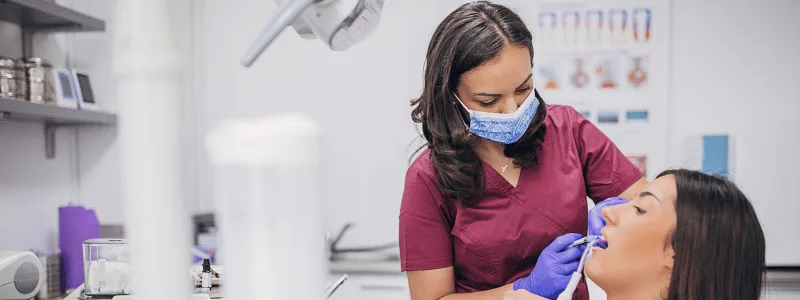Dental staffing shortages have become one of the most pressing operational challenges facing modern clinics. When key team members are absent, whether due to illness, vacation, or unexpected departures, the consequences ripple through every aspect of practice operations. Revenue declines as appointment slots go unfilled, patient satisfaction drops when wait times increase, and remaining staff members face mounting stress and burnout. Trusted temporary dental professionals offer a practical solution to these gaps, providing clinics with immediate access to qualified, credentialed practitioners who maintain care standards while protecting operational stability. Technology-driven platforms like GoTu have transformed how clinics connect with these professionals, offering verified talent pools and streamlined hiring processes that address workforce volatility with speed and reliability.
The Impact of Staffing Gaps on Dental Clinics
A staffing gap occurs when a dental clinic lacks the required number or mix of qualified personnel to meet operational or patient care needs. These gaps create immediate and cascading problems that extend far beyond simple scheduling inconveniences.
Staffing gaps cause lost revenue, frustrated patients, and stressed teams in dental clinics. When a hygienist calls in sick or a dental assistant leaves unexpectedly, clinics face difficult choices: cancel appointments and lose revenue, overburden existing staff, or compromise the quality of patient care. Each option carries significant costs.
The financial impact is substantial. Empty chairs mean unbilled procedures, while rushed appointments can lead to errors that require costly corrections or damage the clinic’s reputation. Patient dissatisfaction grows when they experience long wait times, rescheduled appointments, or interactions with visibly stressed staff members. These experiences drive patients to seek care elsewhere, eroding the practice’s patient base over time.
Remaining team members bear the heaviest burden during staffing shortages. They work longer hours, skip breaks, and juggle responsibilities outside their normal roles. This overextension leads to:
- Increased error rates due to fatigue and rushing
- Declining morale and job satisfaction
- Higher turnover as burned-out staff seek less stressful positions
- Compromised infection control and safety protocols
- Reduced time for patient education and relationship building
The workflow disruptions extend throughout the practice. Front desk staff deal with frustrated calls about cancellations, dentists work without adequate assistance, and administrative tasks pile up as everyone focuses on immediate patient needs. This operational chaos becomes self-perpetuating: stressed staff take more sick days, and the quality of work suffers, creating more problems that require additional time to resolve.
Identifying Your Clinic’s Temporary Staffing Needs
Proactive planning separates clinics that successfully navigate staffing challenges from those that constantly operate in crisis mode. Understanding when and where temporary support makes the most difference allows practices to maintain consistent operations and patient care quality.
Patient volume fluctuations represent the most predictable staffing need. Many practices experience seasonal peaks, back-to-school checkups in late summer, insurance benefit maximization at year-end, or summer vacation scheduling gaps. Analyzing appointment data from previous years reveals these patterns and helps clinics anticipate when temporary staff will provide the greatest value.
Anticipated absences offer another opportunity for strategic planning. When permanent staff schedule vacations, maternity leave, or continuing education, clinics can arrange temporary coverage weeks or months in advance. This forward planning ensures seamless transitions and allows temporary professionals time to familiarize themselves with the practice before their coverage period begins.
Specialty care demands sometimes require temporary expertise that permanent staff may not possess. A practice adding sedation services, expanding pediatric offerings, or covering for a specialist may need temporary professionals with specific credentials or experience. Identifying these needs early allows adequate time for finding appropriately qualified candidates.
To systematically assess your temporary staffing requirements:
- Review appointment schedules for the next 3-6 months to identify high-volume periods
- Collect vacation requests and planned absences from all staff members
- Note any upcoming service expansions or special events requiring additional coverage
- Analyze historical data to identify recurring patterns in no-shows, cancellations, or unexpected absences
- List the specific roles where gaps most frequently occur or have the greatest operational impact
- Determine whether needs are better served by per diem (single-shift) or longer-term temporary placements
Common roles where temporary support proves most valuable include dental hygienists for preventive care appointments, dental assistants to support multiple dentists, front office staff during billing cycles or busy seasons, and dentists to maintain productivity during extended absences.
Choosing a Trusted Temporary Dental Staffing Solution
The quality of temporary staff directly reflects the quality of the staffing partner you choose. Partnering with reputable dental staffing agencies ensures access to qualified temporary candidates while significantly reducing the administrative burden on clinic managers.
A temporary dental staffing agency is an organization or platform that matches dental clinics with licensed, credentialed professionals for short-term, per diem, or contract-based roles. The best agencies specialize exclusively in dental placements, understanding the unique credentials, skills, and cultural fit requirements that general staffing firms often miss.
When evaluating potential staffing partners, prioritize these essential criteria:
Verification and credentialing processes should be rigorous and transparent. The agency should verify current licenses, conduct comprehensive background checks, confirm malpractice insurance, and validate educational credentials before any candidate enters their network. Ask specifically about their verification protocols and how frequently they update credential checks.
Technology integration distinguishes modern platforms from traditional agencies. Advanced systems allow clinics to post shifts with detailed requirements, browse available professionals with complete profiles, communicate directly through secure messaging, and manage scheduling through intuitive interfaces. Technology like online job boards, apps, and social media streamlines dental recruitment and hiring.
Legal compliance and insurance coverage protect both clinics and professionals. Reputable agencies maintain current knowledge of state licensing requirements, OSHA regulations, HIPAA compliance standards, and employment law. They should provide clear documentation of their insurance coverage and explain how liability is handled during temporary placements.
Response time and availability matter when urgent staffing needs arise. The best platforms maintain large networks of available professionals and can often fill critical gaps within hours rather than days. Ask about their average time-to-fill and whether they offer emergency placement services.
Traditional staffing agencies typically operate through phone calls and email, maintaining smaller networks of candidates they’ve personally interviewed. Technology-driven marketplaces like GoTu offer several advantages:
|
Traditional Agencies |
Technology-Driven Platforms |
|
Limited candidate pools in specific geographic areas |
Large networks spanning multiple regions |
|
Business hours availability only |
24/7 access to post needs and browse candidates |
|
Phone tag and email delays |
Real-time messaging and instant notifications |
|
Manual matching based on limited data |
Algorithm-driven matching considering multiple factors |
|
Opaque pricing with negotiated rates |
Transparent, consistent pricing structures |
User reviews and testimonials from other dental practices provide valuable insights into an agency’s reliability, candidate quality, and problem-resolution capabilities. Look for patterns in feedback rather than isolated comments, and pay particular attention to how the agency responds to negative reviews.
Vetting and Onboarding Temporary Dental Professionals
Quality temporary staffing begins with thorough vetting and continues through structured onboarding. Thorough vetting and training of temps maintain work quality and patient care standards.
Credentialing is the process of verifying a dental professional’s qualifications, licenses, and background to ensure compliance with local and industry regulations. Effective staffing agencies handle this complex, time-consuming work before professionals ever appear in their networks, sparing clinics the administrative burden while ensuring safety and compliance.
A comprehensive vetting process includes:
- License verification confirms that professionals hold current, unrestricted licenses in the states where they’ll practice. This includes checking with state dental boards for any disciplinary actions, restrictions, or pending investigations.
- Background checks screen for criminal history, particularly offenses that would disqualify someone from working in healthcare settings. Many agencies conduct both state and federal background checks to ensure thorough coverage.
- Education and certification validation confirms that professionals graduated from accredited programs and hold current certifications in required areas such as CPR, radiology, and infection control.
- Malpractice insurance verification ensures professionals carry adequate coverage and that policies remain current throughout their temporary assignments. GoTu handles OAI and Malpractice insurance for all professionals, so you know you are covered.
Once a temporary professional is matched with a clinic, efficient onboarding accelerates their productivity and integration:
- Pre-arrival documentation: Send office policies, infection control protocols, emergency procedures, and patient management software guides before the first shift. This allows professionals to review materials at their convenience and arrive prepared with questions.
- Credential review: Even though the agency has verified credentials, you may want to maintain your own records.
- Office orientation: Provide a brief tour highlighting supply locations, equipment storage, sterilization areas, break rooms, and emergency exits. Introduce key team members and explain the chain of command for questions or concerns.
- Systems training: Demonstrate your practice management software, digital radiography systems, and any specialized equipment. Provide login credentials and ensure the professional can successfully navigate essential functions.
- Protocol review: Clarify your specific preferences for patient communication, treatment documentation, supply restocking, and end-of-day procedures. Temporary staff appreciate clear expectations rather than having to guess at preferences.
- First-day shadowing: When possible, have temporary professionals shadow a permanent team member for the first hour or two, observing workflows and patient interactions before working independently.
Use this onboarding checklist to ensure consistency:
- Office policies and procedures manual provided
- Credentials copied and filed
- Practice management software login created and tested
- Email and internal communication access established
- Office tour completed
- Emergency procedures reviewed
- Key team members introduced
- First patient appointment shadowed
- Questions addressed and contact person identified
- End-of-shift reporting process explained
Integrating Temporary Staff into Your Clinic Team
Successful integration of temporary professionals requires intentional effort from permanent team members. Fostering teamwork between temporary and permanent staff improves integration and clinic harmony.
Cultural fit matters as much as clinical competence. Temporary professionals who feel welcomed and valued perform better, communicate more openly, and contribute positively to the patient experience. Conversely, temps who feel like outsiders or encounter resentment from permanent staff struggle to reach their full potential, regardless of their qualifications.
Create a welcoming environment through these practices:
Pre-arrival communication sets a positive tone. Send a welcome message introducing the temporary professional to the team, sharing a bit about their background, and expressing enthusiasm about working together. This simple gesture demonstrates respect and helps permanent staff see temps as colleagues rather than strangers.
Peer introductions on the first day should go beyond names and titles. Share something personal or professional about each team member—their role, how long they’ve been with the practice, or a relevant interest. These details provide conversation starters and help the temporary professional connect with team members as individuals.
Mentorship pairing assigns a permanent staff member as the primary contact for questions, guidance, and support. This person should work in a similar role, understand the temporary professional’s responsibilities, and be willing to check in periodically throughout the day. Having a designated mentor prevents the temporary staff member from feeling uncertain about whom to ask for help.
Inclusive communication treats temporary professionals as full team members. Include them in team huddles, staff meetings, and informal conversations. Share relevant information about patients, scheduling changes, or office events. Exclusion, even unintentional, signals that temps aren’t truly part of the team.
Clear expectations about communication preferences help everyone work together smoothly. Explain whether your team prefers direct questions, values independent problem-solving, or expects temps to flag even minor concerns. Clarify how urgent issues should be escalated and who handles different types of decisions.
Social integration during breaks and downtime strengthens relationships. Invite temporary professionals to join lunch conversations, coffee runs, or casual discussions. These informal interactions build rapport and make temps feel comfortable seeking help or offering suggestions.
Feedback opportunities should flow in both directions. Ask temporary professionals for their observations about workflows, patient interactions, or potential improvements. Their fresh perspective often reveals blind spots that permanent staff no longer notice. This consultation also demonstrates that you value their expertise and experience.
Follow this integration workflow:
- Send welcome communication 24-48 hours before the first shift
- Conduct introductions and assign a mentor within the first 15 minutes
- Include the temporary professional in the morning huddle
- Check in at mid-shift to address questions and provide feedback
- Invite participation in team lunch or break activities
- Conduct an end-of-day debrief to gather impressions and answer final questions
- Solicit feedback about the experience through your staffing platform
Monitoring and Maintaining Quality with Temporary Staff
Consistent quality standards apply to all team members, regardless of employment status. Regular feedback and performance evaluations of temps help maintain high standards of patient care.
Performance monitoring for temporary professionals should be more frequent and structured than for permanent staff. Because temps work shorter assignments and may be unfamiliar with your specific protocols, they benefit from regular check-ins that confirm they’re meeting expectations and address any concerns before they become problems.
Implement these monitoring practices:
Mid-shift check-ins provide opportunities to offer course corrections while there’s still time to adjust. A brief conversation (How’s everything going? Any questions about our protocols?”) opens the door for temporary professionals to raise concerns without feeling like they’re interrupting or admitting confusion.
Real-time feedback addresses issues immediately rather than letting them continue. If you notice a temporary hygienist rushing through patient education or a dental assistant struggling with instrument organization, provide gentle guidance in the moment. Frame feedback as helpful coaching rather than criticism.
End-of-shift debriefs create space for reflection and learning. Ask what went well, what proved challenging, and what information would have been helpful to know earlier. This conversation benefits both parties, you learn how to improve orientation for future temps, and the professional gains insights for their next assignment.
Performance metrics should be tracked consistently. Consider measuring:
- Patient satisfaction scores or comments
- Appointment completion rates and on-time performance
- Adherence to infection control and safety protocols
- Accuracy of documentation and charting
- Efficiency in completing standard procedures
- Teamwork and communication effectiveness
Use this simple tracking template:
|
Performance Area |
Rating (1-5) |
Specific Observations |
Improvement Opportunities |
|
Clinical competence |
|||
|
Patient communication |
|||
|
Team collaboration |
|||
|
Protocol adherence |
|||
|
Efficiency |
|||
|
Documentation quality |
Feedback channels should remain open for both temporary professionals and permanent staff. Create safe ways for team members to report concerns about a temp’s performance, and ensure temporary professionals can raise issues about unclear expectations, inadequate orientation, or challenges they’re encountering.
Platform ratings through your staffing service create accountability and help improve future matches. Provide honest, constructive feedback through the platform’s rating system after each assignment. This information helps the agency make better placements and allows the professional to understand their strengths and development areas.
Recognition and appreciation for strong performance motivates temporary professionals and increases the likelihood they’ll accept future assignments with your practice. A simple thank-you, positive feedback shared with the team, or a note through the staffing platform acknowledging excellent work creates goodwill and professional pride.
When performance issues arise, address them directly but professionally. Focus on specific behaviors rather than personal characteristics, explain the impact of the issue, and clarify expectations going forward. If problems persist despite feedback, communicate with your staffing agency about whether the placement is a good fit.
Benefits of Temporary Dental Professionals for Clinics
The strategic advantages of partnering with temporary dental professionals extend well beyond simply filling empty chairs. Temporary dental professionals provide flexibility, cost savings, and improved service quality for practices.
A per diem dental professional is a licensed dental practitioner who works on a shift-by-shift or daily basis, offering staffing flexibility based on a practice’s immediate needs. This flexibility represents the most obvious and immediate benefit—clinics can scale their workforce up or down based on actual demand rather than maintaining excess capacity for occasional peaks.
Operational continuity during absences prevents the cascading problems that staffing gaps create. When permanent staff take vacation, attend continuing education, or face unexpected personal emergencies, temporary professionals ensure that patient care continues without interruption. Appointments stay on schedule, revenue remains stable, and remaining staff avoid the stress of covering additional responsibilities.
Cost effectiveness comes from paying only for the coverage you actually need. While temporary professionals typically command higher hourly rates than permanent staff, clinics avoid the ongoing costs of benefits, paid time off, payroll taxes, and other employment expenses. For coverage lasting days or weeks rather than months, temporary staffing often costs significantly less than permanent hiring.
Access to specialized expertise allows practices to offer services they couldn’t otherwise provide. A general practice might bring in a temporary pediatric specialist for a children’s day, or a small practice might hire a temporary dentist with sedation credentials to serve anxious patients. This flexibility enables service expansion without permanent commitments.
Reduced recruitment pressure gives practices time to find the right permanent staff. Rather than rushing to hire the first available candidate when a key position opens, clinics can use temporary professionals to maintain operations while conducting a thorough search for the ideal permanent team member.
Trial opportunities before permanent hiring reduce the risk of bad matches. Some practices use temporary assignments as extended working interviews, observing candidates in action before extending permanent offers. This approach provides far more insight than traditional interviews and reference checks.
Burnout prevention for permanent staff protects your most valuable assets. When workload spikes threaten to overwhelm your team, temporary professionals provide relief that prevents the exhaustion and turnover that often follow sustained overwork.
Maintained patient satisfaction ensures that care quality doesn’t suffer during transitions. Patients receive timely appointments, adequate attention, and professional service regardless of staffing challenges behind the scenes.
Key benefits at a glance:
- Immediate coverage for unexpected absences or sudden departures
- Flexible scaling to match patient volume fluctuations
- Cost-effective alternative to permanent hiring for short-term needs
- Access to specialized skills and expertise on demand
- Protection of permanent staff from burnout and overwork
- Maintained revenue and productivity during transitions
- Opportunity to evaluate candidates before permanent hiring
- Reduced administrative burden compared to traditional recruiting
The combination of these benefits explains why temporary staffing has shifted from a last-resort option to a strategic component of workforce planning for dental practices of all sizes.
Frequently Asked Questions
How do clinics find qualified temporary dental professionals quickly?
Clinics use specialized dental staffing platforms, such as GoTu, with large networks of pre-vetted professionals, enabling rapid matching through real-time shift posting and instant notifications to qualified candidates.
What are the main advantages of using temporary dental staff?
Temporary dental staff help clinics maintain patient care quality, reduce administrative strain, and provide cost-effective coverage for absences or peak demand periods.
How are temporary dental professionals vetted and credentialed?
Staffing agencies verify licenses, conduct background checks, and ensure candidates meet regulatory standards before sending them to clinics.
Can temporary staff work in specialized or unique dental practice settings?
Yes, temporary dental professionals can fill roles in private practices, community centers, hospitals, and clinics with specialized service needs.
Is temporary dental staffing cost-effective for clinics?
Yes, clinics pay only for needed coverage and avoid long-term employment costs, making temporary staffing a budget-friendly solution for short-term needs.







